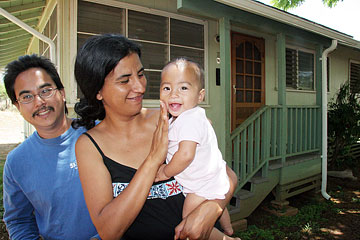 CRAIG T. KOJIMA / CKOJIMA@STARBULLETIN.COMJennielyn Kehau Silva and Chivas Canon, with their 10-month-old daughter, Carly Rose, enjoy a moment at Ohana Ola O Kahumana, a shelter in Waianae. CLICK FOR LARGE |
|
Success stories grow from state shelter
The Waianae facility continues to provide assistance to many on the Leeward coast
STORY SUMMARY »
Since its inception more than four months ago, the Waianae emergency shelter, Paiolu Kaiaulu, has continued to provide safety and assistance to the homeless.
About 200 currently live in the shelter, which recently held a hoolaulea to thank the community for its support.
Some shelter residents already had successfully moved to transitional shelters with the assistance of case workers based at Paiolu Kaiaulu.
Jennielyn "Kehau" Silva, 24, recently moved into Ohana Ola O Kahumana, a transitional shelter, after she stayed at the state shelter for more than three months.
Silva, boyfriend Chivas Canon and their 10-month-old daughter, Carly Rose Silva Canon, now live in a two-bedroom home at the transitional shelter, located several miles from the emergency shelter.
STAR-BULLETIN
FULL STORY »
Jennielyn "Kehau" Silva has ended the cycle of homelessness that began five years ago.
Thanks to officials at Paiolu Kaiaulu, the Waianae emergency shelter the state opened at the beginning of March, the 24-year-old has a new home at Ohana Ola O Kahumana transitional shelter in Waianae.
"They helped me have a roof over my head," Silva said. "They help me with food. Pretty much, it helped me with a lot of stuff."
Paiolu Kaiaulu, which means "lift of encouragement as the journey begins," continues to provide emergency shelter and alleviate homelessness on beaches along the Leeward Coast.
Although people are reluctant to assess the success of the homeless shelter, it is apparent that people are being helped.
So far, caseworkers based at the shelter helped more than a handful of people like Silva move into either transitional shelters, public housing or with family members.
As of July 12, 205 people -- 130 adults and 75 children -- live at the shelter. The shelter's maximum capacity is slightly less than 275 people.
Twenty-two percent of shelter residents also obtained jobs through the assistance of the shelter's caseworkers. "It did benefit a lot of women and children and single men and families that, right now, have the assistance to stand up on their feet and better their lives," said Patty Teruya, chairwoman of the Waianae Neighborhood Board.
"I believe this is a good solution to maximize efforts on the Leeward Coast to get people off the beach and get them started on the road to recovery and having a home," said site director Darryl Vincent, of U.S. VETS-Hawaii, which oversees the shelter.
Two large buildings house the homeless at the shelter, one for families and the other for singles and couples.
All are assigned a unit space sized at 8 by 10 feet, 10 by 12 feet or 12 by 12 feet. Each unit has a locked door with keys issued to each resident, giving a sense of security.
Coin-fed washers and dryers are provided in an open air-building, where breakfast and dinner also are served. Residents are on their own for lunch. Four Matson-like containers are also available on site to provide storage space for residents, as well as space for donated items and supplies.
Women in Need, a nonprofit organization that assists the homeless, holds various classes weekly such as domestic violence, anger management and parenting classes.
Unlike emergency shelters, shelters like Ohana Ola accept those who are able to sustain monthly program fees. Silva's is one of 47 families -- 76 adults and 129 children -- staying at Ohana Ola, a two-year transitional shelter.
About $514 will be taken out of Silva's public assistance at Ohana Ola. Silva currently collects $454 a month from public assistance and $550 from Social Security. Recently, she applied for a security position on the shelter grounds.
Depending on family size, residents live in either a one-, two- or three-bedroom unit. The transitional shelter is currently filled to capacity, program director Dana Newman said. About 20 families are on the waiting list.
Paiolu Kaiaulu project director Cathie Alana noted that Silva and her partner got into transitional housing "because they truly had a desire to want to make their lives better for their child."
"I believe they demonstrated responsibility, and even after they left, they continued their obligation to finish programs at the shelter," Alana said.
 CRAIG T. KOJIMA / CKOJIMA@STARBULLETIN.COMJennielynn Silva walks with daughter Carly Rose to their old unit in the Waianae shelter. They have since moved into the Ohana Ola Kahumana transitional shelter in Waianae. CLICK FOR LARGE |
|
Battling an addiction to crystal methamphetamine or "ice," Silva, who has been homeless on and off for the past five years, stopped her drug use when she found out she was pregnant while living at Neal Blaisdell Park in Pearl City.
She moved into her aunt's home in Nanakuli. But conflict arose between them, which resulted in Silva moving to Nanakuli Beach Park.
To evade police, Silva bounced between Nanakuli Beach Park and Depots Beach Park before she moved to the shelter.
More than three months since she entered the emergency shelter, Silva recently moved to Ohana Ola.
An air mattress is placed in the living room of her 800-square-foot stilted-wooden home where Silva and her boyfriend, Chivas Canon, sleep for now. Their 10-month-old daughter, Carly Rose Silva Canon, sleeps in a playpen at the foot of the mattress.
The home has a kitchen, bathroom and two bedrooms.
"They can leave these places and be sustainable. It's an opportunity for them to get what they need, a job or have a supportive environment or staff in a transitional settings," Alana said.

